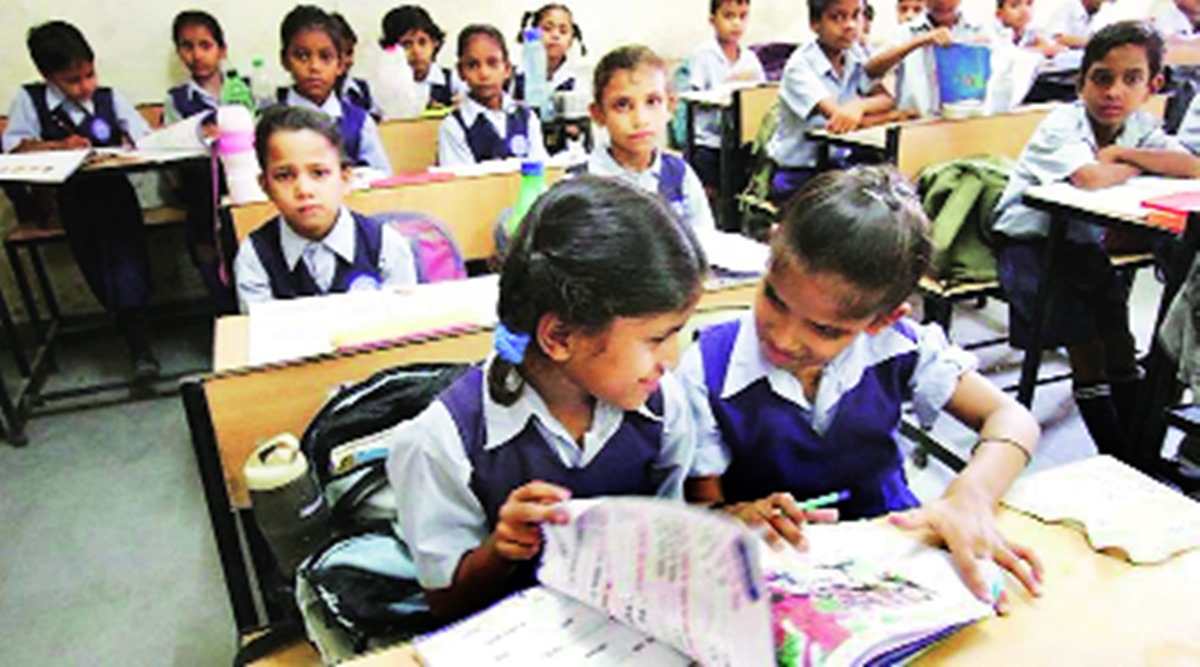 Till 2005, the Ahmedabad Municipal Corporation School Board had 539 schools running in eight mediums - Gujarati, Urdu, Hindi, Marathi, Sindhi, Tamil, Telugu and Malayalam. (File)
Till 2005, the Ahmedabad Municipal Corporation School Board had 539 schools running in eight mediums - Gujarati, Urdu, Hindi, Marathi, Sindhi, Tamil, Telugu and Malayalam. (File)Adapting to the changed preferences for medium of instruction in schools, the Ahmedabad Municipal Corporation School Board which used to run schools in eight Indian languages has now cut it down to four.
Till 2005, the Ahmedabad Municipal Corporation School Board had 539 schools running in eight mediums – Gujarati, Urdu, Hindi, Marathi, Sindhi, Tamil, Telugu and Malayalam. While schools in three of these mediums – Sindhi, Telugu, Malayalam – have closed down, This year, the AMC school board has merged the last remaining two Tamil medium schools in Sabarmati, transferring nearly 30 students to Sabarmati Tamil School Number 2 with a total student strength of less than 60.
Ahmedabad that was known as the Manchester of the East had textile mills that employed migrants from various Hindi speaking and south Indian states, and thus ran schools in their mother language close to ghettos where the workers lived.

Another medium that faces closure is Marathi – from 22 schools in 2005, only three remain, with an enrolment of nearly 85 students at present. If the demand continues to decline like this, these too have to be closed down, says L D Desai, Administrative Officer of AMC School Board.
The city which was founded in 1411 by Sultan Ahmed Shah went to the Marathas in the 18th Century, but schools were established only after the British took over the city. The first school was opened in 1827 in Panchkuva. Owing to these influences, the city municipality ran schools in Gujarati, Urdu and Marathi, later incorporating several South Indian languages and even Sindhi.
Jagdish Bhavsar who was with the Ahmedabad Municipal School Board for 15 years said, “People from across the county would come to work in Ahmedabad and they prefer to work in textile mills. Every textile mill had its own chawl for people from different regions. Keeping this in mind, the local body schools were formed.” Bhavsar himself was a student of an AMC school.
Till 2005 the civic body used to run schools in Telugu and Malayalam, but eventually that closed down. Only one school each remained in these two mediums with 38 and 33 students, respectively.
This reduced to 443 schools in 2006 with the closure of both Telugu and Malayalam medium schools. The schools also faced a shortage of teachers in these mediums.
Similarly, with the shift of students from Sindhi-medium to English, the last two Sindhi medium schools were closed down in 2016.
Raja Adidravidar’s father came to Ahmedabad looking for a job and worked in a private company till 1995 when he died in an accident. “After spending more than 60 years, we are returning to Viluppuram in Chennai with our family to continue education of two children. We were told last year that they would close down the school. There are only two teachers -one for Tamil and the other for Hindi. Also there are hardly any children in the school,” says Adidravidar, resident of Kabir Chowk in Sabarmati, the area dominated by people from the Tamil community. His son and daughter are in Class II and V, respectively.
Robert Adidravidar, resident of Ranip who works as a tailor, said that things have drastically changed over the years. “My two daughters are enrolled in the same school where I had studied, but it is on the verge of closure.” His two daughters, Durga and Tulsi are enrolled in Class VII and II at Sabarmati Tamil School number 2 while his son studies in an English medium private school.
“Once this school closes down, I have no other option but to get them enrolled in a girls’ hostel in Chennai as we do not have anyone back home,” he added.
Parents as well as the school board authorities shared that the declining preference for mother tongue as medium of education and the shift towards English as a medium has led to closure of these schools slowly over the last few years.
This shift is also manifested in the increasing number of English medium schools under the board that has increased from one school in 2013 to 35 in 2020.
“Slowly, preference of parents from other states has seen a shift from mother tongue to English or Gujarati or Hindi. Parents feel that this will benefit students in other states. For instance, study material of higher classes in other languages is difficult to avail,” AMC School Board chairman D J Tomar.
“Also, as teachers are retiring, unavailability of these language teachers is another issue we have been facing for some years now,” he added.
Similarly, Kavita Umale, mother of Roshni who is Class VIII student at Amraiwadi Marathi School number 2, said that they will be left with the options of either returning to their native or getting enrolled in an English medium school once the last Marathi medium school closes down.